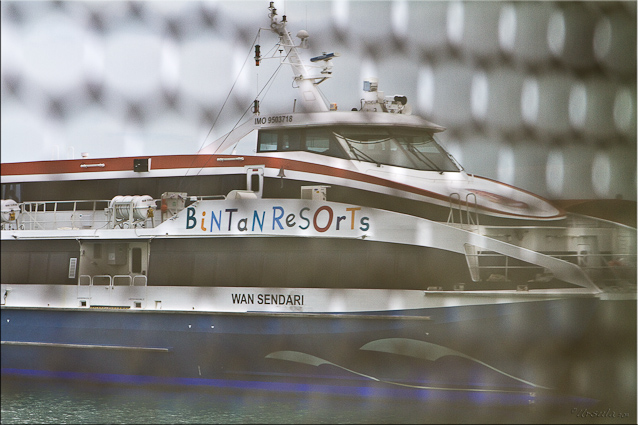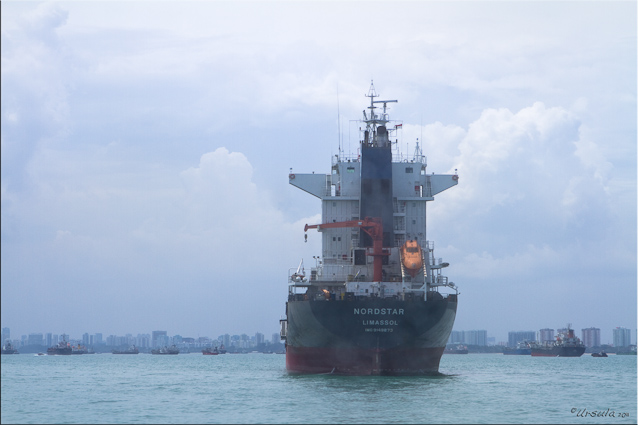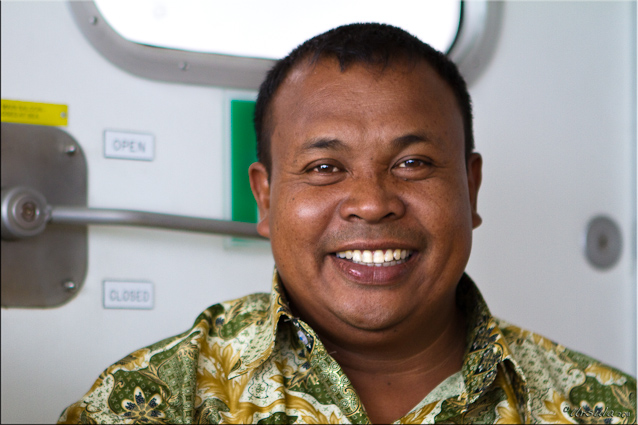Luxurious resort accommodation in developing countries offers up some interesting dilemmas. On the one hand, development for tourism brings money and job opportunities into otherwise under-developed communities. On the other hand, it highlights the contrasts between the have-very-littles and the have-a-lots.

Through the Grill ~ View to the Other Side
The Bintan Resorts complex, on the north coast of Bintan (Negeri Segantang Lada), the largest of Indonesia’s Riau Islands, is a prime example of this dilemma. Part of a larger Indonesia-Singapore cooperation development plan including resorts, industrial parks, and water projects, it is, in effect, a Singapore-consortium-funded leisure space for Singaporeans. Although the resorts attract tourists from many countries (there were Chinese, French, Koreans, and others in the queue for visas-on-arrival when we landed), Singaporeans represent the largest proportion of visitors (almost 30% in 2009). Access is via a 45 minute trip across the South China Sea from Singapore’s Tanah Merah Ferry Terminal in catamarans operated by the resorts themselves.

Big Boat Looming against the Singapore Skyline on the South China Sea

Warm Smile ~ Indonesian Ferry Worker
This oversized gated community (3000 hectares) is currently home to 12 resorts, four signature-designer golf courses, several spas and countless manufactured attractions including go-karts, ATVs, paintball, and jet-skis. You get the idea.
Staff are everywhere; smiling, attentive, and exceptionally well-trained – as they should be at the prices being charged! Although part of Indonesia, the preferred currencies here are Singapore or American dollars. This is understandable: when you are paying $4.50 for a cup of tea, the equivalent Indonesian rupiah (IDR), at over 9000 to the US dollar, would constitute a rather large pile. The average Indonesian income is $4,300 per annum – or less than three cups of over-priced tea per day.

Overcast Winter-Monsoon Weather at the Angsana Resort and Spa, Bintan

Wind in the Winter Palms, Greg Norman Golf Course, Laguna Bintan
The official story is that a 1990 Presidential Decree (25 July 1990), set up the Riao Province Development coordinating team with the mandate to plan and develop projects within the framework of the Indonesia-Singapore cooperation agreement. The outcome, after massive consortium investment, is a good east-west arterial road system and drinkable water across parts of the island. The resorts have their own infrastructure to manage electricity generation and sewage treatment.
The unofficial story, as I understood it, sounded more like under-priced expropriation. The area designated as “Bintan Resorts” was previously mostly home to simple fishing villages, some of which still exist within the resort confines. Unlike the hotel complexes, they have only recently been wired for electricity, which is only provided a few hours daily. These villagers supplement their income by sorting through the tonnes of rubbish that washes up from the shipping lanes of the China Sea and recycling anything of value. Rubbish of no value seems to sit where it lands.

Simple Housing ~ Fishing Village inside the Bintan Resorts

Drying Fish Outside

Baby Inside

Low Tide, Fishing Village, Bintan Resorts

Boat ~ Off Season
The Bintan Resorts development stands in stark contrast to the world outside its barbed-wire perimeter. Screening at the ferry terminal matches that of any international airport. There is only one road into the area from the south of Bintan, and this is complete with a guard house and two checkpoints, a good fifteen minute drive from the resorts themselves. According to company literature, stepped-up security was a response to the hotel bombings in Jakarta in July 2009, but it feels a bit isolating.
Once outside the enclave, life is more down-to earth. Most locals use motorcycles for transport, and with only two formal gas stations on the island, ad-hoc suppliers use bottled petrol and funnels. There is fruit on the trees and fish amongst the mangroves. “Eco tourism” involves a visit to pandanus weavers, an unsophisticated rubber plantation, and a simple smithy. It was a Sunday when we toured, so workers were mostly at rest. We drank fresh coconut milk while locals walked the mudflats in the low light of the late afternoon looking for crabs, or performed Bahasa Indonesian karaoke songs in grass shelters along the beach.

Filling the Car for Our Tour

Kids in the Courtyard Playing Marbles ~ Kampung Sri Bintan

Old Uncle in the Back Yard

"Out House" ~ Ground-Well Housing

Black Chickens

Blacksmith's Forms, Sekuning, Bintan

Rubber Trees

Catching Rubber in a Beer Can

Rubber Roller

Rolled Rubber

Pink Pineapple in the Garden

Boat on the Mud Flats, Sebung Pereh, Bintan

Late Afternoon on Low Tide, Sebung Pereh

Afternoon on Sebung Pereh Beach
Of course, the time always comes when we have to return to our own reality. It seemed rather fitting to me that the smiling ferry worker who was on our boat to Bintan was the same one who tied our boat safely back to the Singapore terminal at the end of our stay.

Tying up on the Dock ~ Tanah Merah Ferry Terminal, Singapore
Wishing you Happy Travels ~ 
where ever you may be!





























.png)


Man you guys get about… fabulous… although pricey I think the resort would have been nice to go back to in the evenings.
Too true, Signe!
[…] the back story, visit my PhotoBlog: https://www.ursulasweeklywanders.com/culture/from-resort-to-reali… No […]